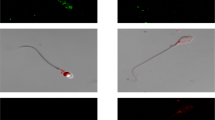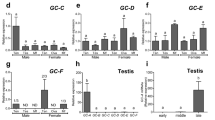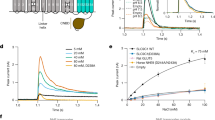Abstract
Eggs attract sperm by chemical factors, a process called chemotaxis. Sperm from marine invertebrates use cGMP signalling to transduce incident chemoattractants into changes in the Ca2+ concentration in the flagellum, which control the swimming behaviour during chemotaxis1,2,3. The signalling pathway downstream of the synthesis of cGMP by a guanylyl cyclase is ill-defined. In particular, the ion channels that are involved in Ca2+ influx and their mechanisms of gating are not known4. Using rapid voltage-sensitive dyes and kinetic techniques, we record the voltage response that is evoked by the chemoattractant in sperm from the sea urchin Arbacia punctulata. We show that the chemoattractant evokes a brief hyperpolarization followed by a sustained depolarization. The hyperpolarization is caused by the opening of K+-selective cyclic-nucleotide-gated (CNG) channels in the flagellum. Ca2+ influx commences at the onset of recovery from hyperpolarization. The voltage threshold of Ca2+ entry indicates the involvement of low-voltage-activated Cav channels. These results establish a model of chemosensory transduction in sperm whereby a cGMP-induced hyperpolarization opens Cav channels by a 'recovery-from-inactivation' mechanism and unveil an evolutionary kinship between transduction mechanisms in sperm and photoreceptors.
This is a preview of subscription content, access via your institution
Access options
Subscribe to this journal
Receive 12 print issues and online access
$209.00 per year
only $17.42 per issue
Buy this article
- Purchase on Springer Link
- Instant access to full article PDF
Prices may be subject to local taxes which are calculated during checkout




Similar content being viewed by others
References
Kaupp, U. B. et al. The signal flow and motor response controling chemotaxis of sea urchin sperm. Nature Cell Biology 5, 109–117 (2003).
Böhmer, M. et al. Ca2+ spikes in the flagellum control chemotactic behavior of sperm. EMBO J. 24, 2741–2752 (2005).
Wood, C. D., Nishigaki, T., Furuta, T., Baba, S. A. & Darszon, A. Real-time analysis of the role of Ca2+ in flagellar movement and motility in single sea urchin sperm. J. Cell Biol. 169, 725–731 (2005).
Kaupp, U. B., Hildebrand, E. & Weyand, I. Sperm chemotaxis in marine invertebrates — molecules and mechanisms. J. Cell. Physiol. 208, 487–496 (2006).
Fluhler, E., Burnham, V. G. & Loew, L. M. Spectra, membrane binding, and potentiometric reponses of new charge shift probes. Biochemistry 24, 5749–5755 (1985).
Bullen, A. & Saggau, P. High-speed, random-access fluorescence microscopy: II. Fast quantitative measurements with voltage-sensitive dyes. Biophys. J. 76, 2272–2287 (1999).
Grinvald, A., Anglister, L., Freeman, J. A., Hildesheim, R. & Manker, A. Real-time optical imaging of naturally evoked electrical activity in intact frog brain. Nature 308, 848–850 (1984).
Kauer, J. S., Senseman, D. M. & Cohen, L. B. Odor-elicited activity monitored simultaneously from 124 regions of the salamander olfactory bulb using a voltage-sensitive dye. Brain Res. 418, 255–261 (1987).
Pugh, E. N. Jr & Lamb, T. D. Handbook of Biological Physics. (eds Stavenga, D. G., DeGrip, W. J. & Pugh, E. N. Jr) 183–255 (Elsevier Science B. V., North-Holland, 2000).
Kaupp, U. B. & Seifert, R. Cyclic nucleotide-gated ion channels. Physiol. Rev. 82, 769–824 (2002).
Heginbotham, L., Lu, Z., Abramson, T. & MacKinnon, R. Mutations in the K+ channel signature sequence. Biophys. J. 66, 1061–1067 (1994).
Darszon, A., Labarca, P., Nishigaki, T. & Espinosa, F. Ion channels in sperm physiology. Physiol. Rev. 79, 481–510 (1999).
Darszon, A., Beltrán, C., Felix, R., Nishigaki, T. & Treviño, C. L. Ion transport in sperm signaling. Dev. Biol. 240, 1–14 (2001).
Hille, B. Ion Channels of Excitable Membranes. (Sinauer Associates Inc., Sunderland, 2001).
Perez-Reyes, E. Molecular physiology of low-voltage-activated T-type calcium channels. Physiol. Rev. 83, 117–161 (2003).
Granados-Gonzalez, G. et al. Identification of voltage-dependent Ca2+ channels in sea urchin sperm. FEBS Lett. 579, 6667–6672 (2005).
Yu, X., Duan, K.-L., Shang, C.-F., Yu, H.-G. & Zhou, Z. Calcium influx through hyperpolarization-activated cation channels (Ih-channels) contributes to activity-evoked neuronal secretion. Proc. Natl Acad. Sci. USA 101, 1051–1056 (2004).
Cook, S. P. & Babcock, D. F. Activation of Ca2+ permeability by cAMP is coordinated through the pHi increase induced by speract. J. Biol. Chem. 268, 22408–22413 (1993).
Beltrán, C., Zapata, O. & Darszon, A. Membrane potential regulates sea urchin sperm adenylylcyclase. Biochemistry 35, 7591–7598 (1996).
Darszon, A. et al. Calcium channels and Ca2+ fluctuations in sperm physiology. Int. Rev. Cytol. 243, 79–172 (2005).
Matsumoto, M. et al. A sperm-activating peptide controls a cGMP-signaling pathway in starfish sperm. Dev. Biol. 260, 314–324 (2003).
Solzin, J. et al. Revisiting the role of H+ in chemotactic signaling of sperm. J. Gen. Physiol. 124, 115–124 (2004).
Gomez, M. & Nasi, E. Activation of light-dependent K+ channels in ciliary invertebrate photoreceptors involves cGMP but not the IP3/Ca2+ cascade. Neuron 15, 607–618 (1995).
Fain, G. L. & Lisman, J. E. Membrane conductances of photoreceptors. Prog. Biophys. Molec. Biol. 37, 91–147 (1981).
Gauss, R., Seifert, R. & Kaupp, U. B. Molecular identification of a hyperpolarization-activated channel in sea urchin sperm. Nature 393, 583–587 (1998).
Hagen, V. et al. Highly efficient and ultrafast phototriggers for cAMP and cGMP by using long-wavelength UV/Vis-activation. Angew. Chem. Int. Ed. 40, 1046–1048 (2001).
Hagen, V., Benndorf, K. & Kaupp, U. B. Dynamic Studies in Biology (eds Goeldner, M. & Givens, R. S.) 155–178 (Wiley-VCH, Weinheim, 2005).
Acknowledgements
This work was supported by the Deutsche Forschungsgemeinschaft, KA 545/10-4 and the Fonds der Chemischen Industrie. We thank members of the Kaupp lab for critical reading of the manuscript, and A. Eckert and H.D. Grammig for preparing the manuscript and figures. We thank M. Gomez and E. Nasi for continous supply of material.
Author information
Authors and Affiliations
Corresponding author
Ethics declarations
Competing interests
The authors declare no competing financial interests.
Supplementary information
Supplementary Information
Supplementary Figures S1, S2, S3, Supplementary Table and Information (PDF 476 kb)
Rights and permissions
About this article
Cite this article
Strünker, T., Weyand, I., Bönigk, W. et al. A K+-selective cGMP-gated ion channel controls chemosensation of sperm. Nat Cell Biol 8, 1149–1154 (2006). https://doi.org/10.1038/ncb1473
Received:
Accepted:
Published:
Issue Date:
DOI: https://doi.org/10.1038/ncb1473
This article is cited by
-
Comparative genomic analysis suggests that the sperm-specific sodium/proton exchanger and soluble adenylyl cyclase are key regulators of CatSper among the Metazoa
Zoological Letters (2019)
-
The solute carrier SLC9C1 is a Na+/H+-exchanger gated by an S4-type voltage-sensor and cyclic-nucleotide binding
Nature Communications (2018)
-
Crystal structure of a Ca2+-dependent regulator of flagellar motility reveals the open-closed structural transition
Scientific Reports (2018)
-
Single-molecule detection with a millimetre-sized transistor
Nature Communications (2018)
-
Ca2+ efflux via plasma membrane Ca2+-ATPase mediates chemotaxis in ascidian sperm
Scientific Reports (2018)



